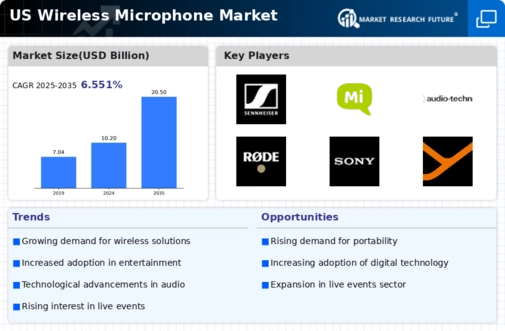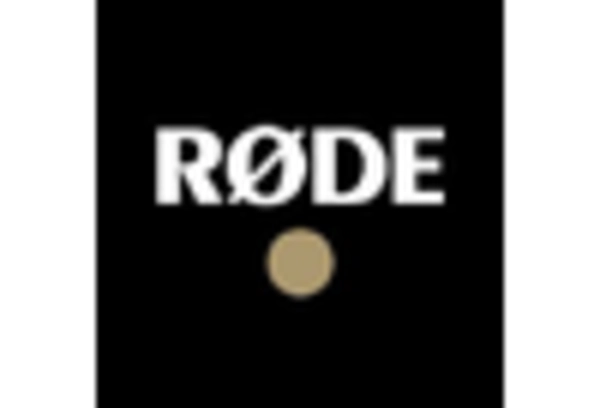Rising Adoption in Live Events
The wireless microphone market experiences a notable surge in demand due to the increasing adoption of wireless microphones in live events, including concerts, conferences, and theatrical performances. As event organizers prioritize high-quality audio experiences, the market is projected to grow at a CAGR of approximately 8% from 2025 to 2030. This growth is driven by the need for mobility and flexibility in sound production, allowing performers and speakers to move freely without being tethered to cables. The wireless microphone market is thus becoming essential for enhancing audience engagement and overall event quality, as it enables seamless audio transmission and reduces setup time. Furthermore, advancements in wireless technology, such as improved frequency management and reduced latency, contribute to the appeal of wireless microphones in these settings.
Expansion in Broadcast and Media
The wireless microphone market is significantly influenced by the expansion of the broadcast and media sectors. With the rise of digital content creation, including podcasts, vlogs, and live streaming, there is an increasing demand for high-quality audio equipment. The market is expected to witness a growth rate of around 7% annually as content creators seek reliable and portable audio solutions. Wireless microphones are particularly favored for their ease of use and ability to deliver professional-grade sound without the constraints of cables. The wireless microphone market is thus positioned to benefit from this trend, as more media professionals recognize the importance of clear audio in enhancing viewer experience. Additionally, the integration of wireless microphones with advanced recording technologies further boosts their adoption in this sector.
Growth in Educational Institutions
The wireless microphone market is experiencing growth driven by the increasing adoption of wireless microphones in educational institutions. As schools and universities seek to enhance the learning experience, the demand for effective audio solutions has risen. The market is anticipated to grow at a rate of about 5% per year, as educators recognize the benefits of using wireless microphones for lectures, presentations, and interactive learning. These devices facilitate better communication between instructors and students, particularly in larger classrooms where sound clarity is essential. The wireless microphone market is thus becoming integral to modern educational environments, as it supports diverse teaching methods and fosters student engagement. Furthermore, the trend towards hybrid learning models further propels the need for reliable audio equipment in educational settings.
Increased Focus on Health and Safety
The wireless microphone market is also influenced by an increased focus on health and safety, particularly in public speaking and performance environments. As organizations prioritize hygiene and safety protocols, the demand for contactless audio solutions has risen. Wireless microphones, which eliminate the need for shared equipment, are becoming a preferred choice in various settings, including corporate events and public gatherings. The market is projected to grow by approximately 4% annually as users seek to minimize health risks while maintaining high audio quality. The wireless microphone market is thus adapting to these changing consumer preferences, with manufacturers developing products that emphasize hygiene features, such as antimicrobial coatings and easy-to-sanitize designs. This trend reflects a broader societal shift towards health-conscious practices in all aspects of life.
Technological Innovations in Audio Equipment
Technological innovations play a crucial role in shaping the wireless microphone market. The introduction of advanced features such as digital signal processing, noise cancellation, and enhanced battery life has made wireless microphones more appealing to users across various sectors. The market is projected to grow by approximately 6% annually as manufacturers continue to innovate and improve product offerings. These advancements not only enhance audio quality but also increase the reliability and durability of wireless microphones, making them suitable for diverse applications, from professional audio production to casual use. The wireless microphone market is thus likely to see a shift towards more sophisticated products that cater to the evolving needs of consumers, including features that facilitate easier connectivity and integration with other devices.
















Leave a Comment